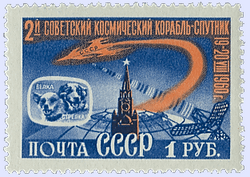Engineering:Belka and Strelka
Belka (Белка, literally, "squirrel", or alternatively "Whitey") and Strelka (Стрелка, "little arrow") are dogs that spent a day in space aboard Korabl-Sputnik 2 (Sputnik 5) on 19 August 1960 before safely returning to Earth. They are the first higher living organisms to survive an orbital trip in outer space.[1]
They were accompanied by 42 mice, a grey rabbit, two rats, flies, and several plants and fungi. All passengers survived. Sputnik 5 made 17 revolutions around the Earth and spent 27 hours in orbit. These were the first Earth-born creatures to orbit Earth and return alive, and the first recovered since February 20, 1947, when fruit flies were flown into space on a suborbital flight by the U.S. and survived.[2]
The objective of the mission was to check and understand the organisms' reactions to exposure of space's zero gravity.[3]
Strelka went on to have six puppies with a male dog named Pushok who participated in many ground-based space experiments, but never made it into space.[4] One of the puppies was named Pushinka (Пушинка, "Fluffy") and was presented to President John F. Kennedy by Nikita Khrushchev in 1961. A Kennedy dog named Charlie and Pushinka mated, resulting in the birth of four puppies that JFK referred to jokingly as pupniks.[5] Two of their puppies, Butterfly and Streaker, were given away to children in the Midwest. The other two puppies, White Tips and Blackie, stayed at the Kennedy home on Squaw Island but were eventually given away to family friends.[4] Pushinka's descendants were still living as of 2015.[6] A photo of descendants of some of the Space Dogs is on display at the Zvezda Museum in Tomilino outside Moscow.[7]
A Russian animated feature film called Belka and Strelka: Star Dogs (English title: Space Dogs) was released in 2010.[8]
See also
- Animals in space
- Soviet space dogs
- List of individual dogs
References
- ↑ The first creatures in space were fruit flies, and the first to orbit were dogs.
- ↑ Georgiou, Aristos (November 3, 2019). "Laika the dog: These are all the animals that have been launched into space". https://www.newsweek.com/laika-dog-all-animals-space-1469393.
- ↑ "The Remarkable Return: The First Animal To Return Alive From Space" (in en-gb). https://theknowledge50.blogspot.com/2023/02/belka-and-strelka-first-animal-to.html.
- ↑ 4.0 4.1 John F. Kennedy Presidential Library & Museum. Reference Desk: Pets. Accessed 8 July 2007
- ↑ Bark At the Moon: A Short History of Soviet Canine Cosmonauts From About.com Space / Astronomy. Accessed 8 July 2007
- ↑ Mosher, Dave. "I traveled to Russia and met the first dogs to ever survive space in this rare museum". https://www.businessinsider.com/belka-strelka-first-dogs-survive-space-moscow-space-museum-2015-8.
- ↑ Dogs in Space: James M Skipper's visit to the NPO Zvezda Museum, The Skipper Family magazine. Accessed 7 July 2007
- ↑ "Space Dogs". https://www.boxofficemojo.com/release/rl3815802369/weekend/.
 |


